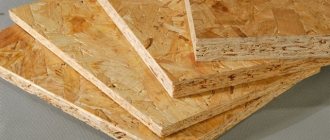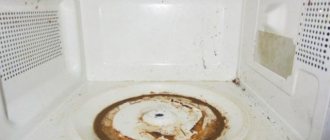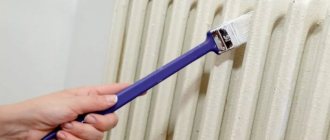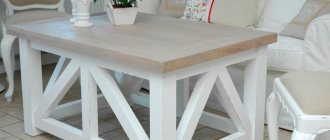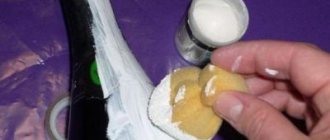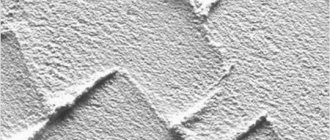Difficult operating conditions inside a microwave oven can, over time, lead to the appearance of cracks in the coating of the walls. And then, for safety, it is necessary to eliminate the defects and paint the surface. But not every type of paint will withstand such conditions and will be considered suitable for contact with food. For this reason, you need to know exactly what is allowed to paint the inside of the microwave; this will be discussed further.
What are microwave ovens coated with during their production?
It is advisable to understand what kind of microwave paint was used by the manufacturer. Then it will be easier to choose the appropriate option for updating the damaged layer. The following types of coatings are commonly used:
- Enamel is the most popular option due to its low cost. However, from time to time they become covered with bubbles, and the surface becomes peeling, and the coating is also easy to scratch;
- Stainless steel is wear-resistant, flaws do not harm the coating, but the presence of scratches leads to the rapid formation of dirt, which is difficult to remove;
- Ceramic and bioceramic coating is smooth, easy to clean, resistant to temperature, but may chip from impact.
Thus, microwave enamel and ceramics require a new coat of paint so that the performance of the device does not suffer. Stainless steel can work without problems, but it will be difficult to clean the surface if it has scratches.
It is advisable to understand what kind of microwave paint was used by the manufacturer.
Types of paints
There are the following main types of paints and enamels used for processing microwave ovens.
Special organic food
This is perhaps the best option, although not the cheapest. Such coatings are absolutely resistant to all types of adverse influences, such as elevated temperatures, alcohol fumes, acids, high levels of humidity, and are safe for health, since the compositions from which they are made are developed specifically for the food industry. Organic paints work best on aluminum or metal.
Enamels for the food industry are standardly used for painting containers intended for storing drinking water and other products, so the substances used to create them meet the most demanding requirements. They are a combination of zinc powder and a specially processed alcohol solution.
Enamels perfectly protect the microwave from the formation and development of corrosion due to the so-called “cold galvanizing”, withstand temperatures up to 100 0C and are very water resistant.
Electrically conductive
The composition of such paints can be developed on the basis of zinc, aluminum, silver or shungite. After drying, the coating becomes resistant to negative external factors and can withstand temperatures up to 150-2000C. Despite all their advantages, they are rarely used in everyday practice because their price is high.
Shungite
Shungite is a rock characterized by its high energy-saving function. One ton of rock contains 300 kg of shungite carbon, which is significantly more active than coke. Shungite is distinguished by such properties as electrical conductivity, strength and density, which make it ideal for creating heat-resistant and antistatic bases. Therefore, such options are perfect for microwave ovens.
Causes of coating deformation
Before you paint the inside of a microwave at home, you should understand what can cause the layer to peel off. When heating food, greasy particles and other elements may fall onto the walls of the appliance and contaminate the surface. If you clean the base with rough brushes or other abrasive means, you can damage the coating.
Defects in the form of a violation of the integrity of the coating must be eliminated. From their appearance, rust will begin to spread over the entire surface, and other defects may also arise; what the consequences will be depends on the type of painted surface. If the enamel chips off inside the microwave, what should you do? The answer is to paint the base again.
Defects in the form of a violation of the integrity of the coating must be eliminated.
Types of paints
Stores today offer a huge range of paint and varnish products, so you can get confused as to which composition is best to choose to paint a microwave at home. Here is a list of paint mixtures that are suitable for painting the inside of a microwave oven:
Organosilicon dyes have the highest resistance to extreme temperatures and are suitable for painting the inside of a microwave. These paints are resistant to mechanical, chemical and high humidity. To paint with this composition, you can use a regular brush; the mixture spreads evenly on any type of metal, and perfectly protects it from corrosion and rust. After applying the paint, an effect similar to cold galvanizing is created, so the microwave oven can be used for a very long time;
- electrically conductive. They consist of silver, aluminum and zinc; after drying, the coating becomes resistant to the adverse effects of various factors. For example, the paint layer can be operated at a temperature of 170-200 degrees. Although electrically conductive compounds are not cheap, they are great for painting the inside of a microwave oven. These paints do not emit any harmful or toxic substances when heated, and are absolutely safe for humans. The most popular electrically conductive paint is from Zinga;
- shungite. Shungite is very similar in its characteristics to graphite; it is a natural material that is an electrically conductive composition. After painting, the device becomes fireproof; shungite mixtures are used in the field of finishing; they are well suited for painting a microwave at home. Shungite coating can easily heat up to a temperature of 300 degrees and forms an antistatic film that is completely safe for humans;
- automotive acrylic paints. They have increased strength and high reliability, so they are suitable for painting microwaves. Most often, these mixtures are supplied in aerosol cans, making their use very convenient; you can easily paint any hard-to-reach places. These paints are reasonably priced; one can is enough to paint two layers of the inside of a microwave oven. Acrylic dyes provide excellent protection against corrosion, rust, withstand the negative effects of steam, moisture, grease and strong heat without damage, are environmentally friendly and durable;
- special coloring agents for household appliances. These are enamels based on epoxy resin, for example, New-ton dye. It is produced in the form of an aerosol and is white in color. The disadvantage of the composition is the ability to withstand temperatures of a maximum of 100 degrees, so these mixtures are used more often for treating the outside of microwaves.
Inner covering material
One of three types of paint for the inside of a microwave oven is used: enamel, ceramic or stainless steel. Each type has its pros and cons. Stainless steel is the most resistant; if flaws have formed on it, this will not harm the use of the device, but will complicate the cleaning of its surface; special means must be used.
Ceramics are easy to clean, but have a low level of resistance to mechanical shock. Enamels become corroded over time when exposed to high temperatures.
Stainless steel is the most resistant; if flaws appear on it, this will not harm the use of the device.
What are the dangers of using a microwave when the enamel inside has peeled off?
Enamel in a microwave oven not only serves as an aesthetic surface. In addition to its external properties, it provides protection against various bacteria for heated food and saves the housing from wear, contamination or basic breakdown.
When the enamel chips, the “iron box” is exposed. It would seem that there is nothing wrong. The problem is that unprotected metal can begin to corrode. If you aggravate this process, then a hole will appear due to rust, and fire can pass through. As a result, the device may catch fire or simply fail.
Important! A stream of fire can escape through a rusted hole in the enamel.
Among other things, the very presence of a metal surface (object) inside threatens the possibility of an explosion. The metal acts as a shield for microwaves and has excellent electrical conductivity. The latter circumstance just causes the redistribution of currents on it, which, in the presence of an electromagnetic field around, leads to breakdown.
Advice! Do not use metal objects to heat food in the microwave.
Is it possible to use a microwave if the paint inside is cracked?
Of course, if you have already heated up your lunch and then only notice that the surface of the inner chamber is damaged, there is no need to throw it away. The products are reliably protected from the penetration of high-frequency waves by a metal casing. If the metal is not rusted, but only the integrity of the enamel is damaged, it is not dangerous. But it is better to refuse further use of the device in this condition.
The fact is that during cooking, a certain amount of steam is generated inside the microwave oven. When iron interacts with moisture, it begins to corrode. Therefore, at a certain moment, in a place where there was just a small chip of paint, a hole may appear due to rust. It is through this hole that the radiation will penetrate into the chamber itself. Moreover, this situation also threatens that due to the high temperature of the internal coil, without proper protection, the device may even catch fire.
Important! If the enamel is chipped, a hole in the metal may appear in this place, which can even lead to a microwave fire.
However, if a defect is discovered, it is not necessary to throw away the microwave and run to the store for a new one. The situation can be saved by nitro paint or any other enamel that is safest for everyday use (the degree of safety is usually indicated on the can).
Is it possible to use a microwave with damaged enamel?
A reasonable question that arises among owners of a microwave oven that has scratches is whether it is possible to use such a device? A small number of defects does not interfere with the use of the stove, but in any case they will increase over time due to high temperature exposure. A layer of microwave paint inside serves to protect food from electromagnetic radiation.
For this reason, repair work is necessary, otherwise eating food heated in such a microwave will be harmful. The enamel itself, which has peeled off, will not cause harm, but electromagnetic waves are unsafe. Therefore, either the equipment will need to be disposed of, or the paint layer from the inside will need to be restored.
Also, rust and cracks will lead to interruptions in operation, and eventually the stove will break.
A small number of defects does not interfere with the use of the stove, but in any case they will increase over time due to high temperature exposure.
The enamel peeled off in the microwave: can I use it?
It is not recommended to use a microwave with enamel damaged by corrosion.
The pieces of falling paint themselves are not dangerous, even if they enter the body along with food, since food-grade enamel is used to paint the inner surface. But through cracks and areas with peeling paint, electromagnetic waves enter the microwave oven, negatively affecting the food being prepared.
It is theoretically possible to use a stove with a cracked coating, but if you do not paint over small defects, they will begin to increase in size. Such a stove will either have to be completely restored or thrown away.
Types of coating
It is important to choose the right way to paint the inside of the microwave to prevent rust. Manufacturers choose what to cover the inside of the microwave among three options.
The first, most budget-friendly enamel for the microwave inside, but it does not last long, and corrosion quickly spreads to the base. A modern option is the use of ceramics or bioceramics, which have a smooth texture, but are not considered resistant to external impacts. Stainless steel is resistant to external factors and lasts a long time.
A modern option is the use of ceramics or bioceramics, which have a smooth texture, but are not considered resistant to external impacts.
How to restore enamel in the microwave
A microwave with enameled walls can be repaired: it is enough to paint the entire chamber or only the damaged areas. The main thing is to choose the right way to restore the enamel for the microwave. It should be heat-resistant paint without toxic compounds in the composition.
The ideal option is organic paints used in the food industry. They are used to paint, for example, dishes or parts of electrical appliances that come into direct contact with food. They do not contain toxic components and demonstrate resistance to high temperature and humidity, acidic environments and other chemical influences.
Due to its durability, such paint will protect the metal casing of the microwave from rust, which means it will extend the life of its safe operation. The only disadvantage of edible enamels is their high cost.
The most budget-friendly choice is spray acrylic paint. One can is enough to paint the entire inside surface of the camera. If there are a lot of enamel blisters or they are large in area, you may also need a can of acrylic primer to pre-treat the surface.
You can also use electrically conductive paints that contain shungite, aluminum, silver or zinc. They adhere well to the surface, and when dry they form a smooth and durable layer of exceptionally high heat resistance: this coating can withstand temperatures up to 200°C.
Stages of painting a camera
Regardless of the choice of enamel for the microwave, the main stages of restoration will be common to all:
- Thoroughly wash the entire inner surface of the camera, making sure that no water gets into the magnetron or backlight output holes.
- Degrease the walls, bottom and ceiling of the chamber with alcohol or acetone.
- Use sandpaper to clean areas with damaged enamel.
- Carefully inspect the chamber for swelling of the enamel: it is also better to open and clean such areas.
- Protect all openings inside the camera with tape, tape or similar material. It is better to seal with overlapping layers so that the paint does not get inside the stove body.
- Place a bag or film on the microwave door and secure with tape.
- Install the oven with the door open at an angle of 45° to the floor so that the back wall rests on the wall of the room.
- Wear gloves and a respirator.
- Apply paint in a convenient way: roller, brush or spray from a spray can.
The second layer is applied after the first has dried. This process can be speeded up using a household hair dryer. Upon completion of painting, leave the oven open until completely dry, i.e. for about a day.
Advice! Before further use, the oven is washed from the inside with a solution of laundry soap, and then a container of clean water is boiled in it to get rid of residual odors.
What paint can you use to paint a microwave?
Few people know the paint for painting the inside of a microwave oven, so many, realizing that the coating has deteriorated, simply throw out the oven. However, there are several options for updating the layer, parameters that should be taken into account when choosing paint:
- The color of the coating must be matched exactly to the original shade;
- Resistance to high temperatures;
- Should not contain toxic elements.
There are several options for updating a layer.
Food grade or organic
Professionals call high-quality and suitable types of coatings for microwaves KO-5102 and BEP-5297. The downside is the high cost, but the funds have many more advantages:
I can withstand elevated temperatures without problems;
- Resistance to wet conditions;
- Does not contain toxic substances;
- Protects against rust;
- Approved by the Ministry of Health.
Professionals call high-quality and suitable types of coatings for microwaves KO-5102 and BEP-5297.
Electrically conductive
The peeling layer can be painted with Zinga paint or KO-8111, the products are distinguished by the creation of a highly durable coating, their cost is low, and they have a high level of adhesion.
The peeling layer can be painted with Zinga paint or KO-8111.
Shungite
Shungite products are considered to be paints with the best level of electrical conductivity. A durable and dense layer is created that can withstand the harsh conditions of a microwave oven. Helps save energy.
A durable and dense layer is created that can withstand the harsh conditions of a microwave oven.
Acrylic car
The use of acrylic coating is very convenient, the products are also sold in aerosol form; for a microwave oven it will be enough to use one can. The cost of paint is low, there are a huge number of colors, but white is usually required for the microwave.
The use of acrylic coating is very convenient, the products are also sold in aerosol form; for a microwave oven it will be enough to use one can.
Top 5 best
Construction hypermarkets offer a wide selection of metal paints. TOP 5 best paint options for painting the inside surface of a microwave:
KUDO
Heat-resistant enamel KUDO organosilicon . Ideal for painting metal surfaces. Due to the fact that the enamel is sold in an aerosol can, the composition is easily applied to hard-to-reach places.
The paint layer can withstand heating temperatures up to 650°C. The enamel dries quickly under natural conditions, does not crack or peel, and creates a perfectly smooth surface.
The average cost is 160 rubles. (570 ml can). Read reviews here.
Decorix
Decorix universal acrylic enamel is a high-quality composition intended for painting:
- metal,
- glass,
- mineral surfaces.
After application, it forms a thin but very durable coating that is resistant to fading and high temperatures. Dries quickly (one coat - thirty minutes). A variety of enamel shades allows you to select the desired option in each specific case.
The average cost of a can of enamel (520 ml) is 200 rubles. Read reviews here.
Elcon
Elcon heat-resistant enamel is intended for painting metal surfaces that are subject to sudden temperature changes and high humidity during operation.
The paint is resistant to aggressive environments (mineral oils, soluble salts). Can be used for painting household appliances (does not emit toxic fumes). Complete drying time does not exceed 72 hours.
The average cost is 470 rubles. (1 liter jar). Read reviews here.
Certa
Paint Spectrum Certa heat-resistant enamel is an excellent solution for treating metal surfaces exposed to high temperatures (up to +1000°C).
In addition to thermal insulation properties, the paint has high protection against moisture and aggressive environments. No primer required during application.
The average cost is 350 rubles. (spray can 520 ml). You will find reviews here.
Panzer
Panzer rust paint contains components that smooth out rust-affected surfaces, forming a perfectly smooth coating that is resistant to high temperatures. The paint is environmentally friendly and suitable for interior work.
The average cost of a can of paint (volume 750 ml) is 650 rubles. You will find reviews here.
Rules for painting the inside of a microwave oven
To do the painting yourself, you need to know the important rules of the process. Experts note the following points:
- You need to disconnect the device from the network, install it on a flat base with the door facing up;
- It is necessary to cover all sections where paint and dirt cannot get in with electrical tape or tape;
- Poorly adhered coating wrinkles;
- Uneven areas should be removed using fine sandpaper;
- If the corrosion occupies a large area, then a special converter is used;
- Remove the old layer and all types of contaminants, treat the base with alcohol.
Remove the old layer and all types of contaminants, treat the base with alcohol.
Painting stages
We found out how to restore the original beauty and integrity of the surface. All that remains is to find out how to apply paint correctly. The process can be divided into 4 successive stages:
- Sandpaper is used to clean surfaces from rust, bubbling, and peeling paint.
- Degrease with an alcohol solution.
- All holes inside the chamber are sealed with tape.
- Dye is applied. Wait for it to dry completely. If necessary, cover with a second layer.
As it turns out, the main reason for premature microwave wear is careless maintenance. If you properly clean the microwave oven chamber from grease deposits, there will be no problems. Do not rush to throw away the oven due to defects in the coating. Choose one of the dyes discussed above and paint it quickly - don’t wait for it to break.
How to paint the inside of a microwave at home, instructions
The master needs to work in protective gloves; a good level of ventilation is created in the room. It is advisable to cover the working surface with oilcloth so as not to get dirty. After preparing the base, perform the following steps:
- If the aerosol type of application is chosen, then the oven is placed on its side and the deep areas begin to be painted;
- The roller should not be heavily soaked with paint, otherwise smudges will appear; the layer should be thin. For difficult areas use a brush;
- A two-layer coating is made, each should dry well;
- Aerosol spraying is done in a zigzag motion;
- After painting is completed, the quality of the coating is assessed; if necessary, another layer can be applied;
- The electrical tape is removed only when the layer is completely dry;
- The oven will not be able to be used for its intended purpose for several more days.
The master needs to work in protective gloves; a good level of ventilation is created in the room.
Dyeing process
When the material for painting the microwave has already been selected and the preparation of the interior has been completed, you can proceed to the main action - painting. It is important to carry out all the steps accurately so that the quality of the coating is at a high level:
- Internal components that do not need to be painted should be sealed with masking tape. The same should be done with the ventilation grille to prevent debris and dye from getting there.
- Painting should begin from the far internal parts of the device, moving towards the door. The paint is applied in a thin, even layer, so a foam roller is used for this type of work. When using enamel in a spray can, coloring is done using zigzag movements. It is necessary to wait until the first layer has completely dried, after which you need to apply the second using the same technology.
- When all the internal parts have already been painted, you can finish the outside. For this purpose, it is better to use aerosol paint - it will lie more evenly on the surface and will not leave smudges or streaks, as is the case with painting with a brush.
- After the microwave is completely dry, you can remove the masking tape that was used to hide individual elements. If small defects are found, such as dried drops of paint, they can be eliminated with a cotton swab dipped in solvent.
Coloring stages
By painting the inside of a microwave oven, you can extend its service life for a long time, but the work must be carried out in compliance with a certain order:
- Areas with paint bubbles, the falling layer must be eliminated using sandpaper.
- Degreasing is carried out.
- The connectors necessary for the operation of the device are protected with tape.
- The surface is painted; it is decided whether to do a 2nd layer after drying the 1st, assessing the result visually.
Whether to do a 2nd layer is decided after drying the 1st, assessing the result visually.
How to paint
Despite the fact that painting is a simple process, you can’t do it without tools and equipment. Therefore, you need to stock up:
- paint and a brush, a narrow roller if the composition was purchased in cans;
- solvent or alcohol for degreasing surfaces;
- fine-grained sandpaper;
- masking tape;
- acid rust converter if it affects a large area;
- protective gloves and clothing.
We paint the microwave with heat-resistant paint.
Sequencing
- The oven is disconnected from the network and placed with the door up in a place convenient for work.
- First of all, use adhesive tape to cover places where paint and dirt are undesirable to get in (air duct, wave duct, etc.);
- Places where the previous paint has peeled off are cleared of its remnants.
- If rust has not had time to form, then use sandpaper to smooth out irregularities and damage.
- If there are large areas affected by rust, they are treated with an acid converter.
- After cleaning all surfaces, you need to remove dust and dirt from them with a cloth.
- Then degreasing is carried out.
- Remember to wear gloves and open the window to avoid inhaling solvent and paint fumes. If possible, it is preferable to carry out painting outdoors.
- In order not to spread dirt in the workplace, you need to lay film or newspapers on it.
- When using can paint, the stove is placed on its edge, and painting begins with surfaces located in the depths.
- To avoid drips, you do not need to put a lot of paint on the roller, which is applied in a thin layer. The corners are painted with a brush.
- After the paint has completely dried, a second layer is applied.
- Spray paint is applied in a zigzag pattern without delay to form an even layer.
- After drying and evaluating the results, a second coat can be applied if necessary.
- After drying, the tape is removed.
- Wait for the paint to dry completely and have time to set properly.
- After the restoration is completed, the microwave cannot be used for 2 - 3 days.
In order for the coating to last a long time, it is necessary to remove them immediately after the appearance of dirt using gentle detergents. This will eliminate the fuss with painting and will be cheaper. If the coating is damaged, you must immediately paint over it, without waiting for it to grow. If you leave everything as is, it is possible that harmful substances will get into the food.
In the video: painting a microwave oven with heat-resistant paint:
Painting a Samsung / HI-Temp microwave oven
I didn’t take any more photos, I was just lazy.
Total: we have a rusty conventional module and holes in the rear wall of the working chamber, the rest, with the exception of thermal insulation that has fallen into powder, deposits of grease and a little rust in places, is in order.
In search of options and methods of repair, I went to the Internet. In general, I thought, if the repair fails, to make a multi-purpose microwave gun from the magnetron for various experiments, the possibilities and dangers of using which I read on Habré. From an explosive transformer you can make a small apparatus for arc or resistance welding. But these are dreams, meanwhile I continued to dig on the Internet.
After a couple of days of leisurely thought and reading forums, I came to the decision to make a steel patch on the back wall of the microwave and screw it on, because... upon detailed inspection, it turned out that the heat shield on the conventional module was rusted through, and in principle we do not use the oven mode in the microwave. To prevent the patch from rusting, I will cover it with paint. The Internet told me about this that it should be specially coated with food paint, but since it is very problematic for mere mortals to find it in small packaging, then you can get by with aerosol paint from an acrylic-based can.
I made the patch at work from sheet steel, because... It is connected with laser cutting of sheet metals and making all sorts of crap for personal purposes is not a problem. I drew it in AutoCAD and sent it to production.
I also bought a rust converter, a degreaser and the paint itself for further work.
While the patch was being made, I started cleaning the microwave body of everything that had accumulated there over the years of use; everything stuck and burned so well that only a metal sponge (shavings) helped me to clean it. Then, to at least somehow extend the life, I treated the rust spots with a converter for further painting.
How to paint the inside of a stove from rust
Corrosion damage spreads if the damaged areas are not covered with paint in a timely manner. If the problem has become big, then you can choose the following coloring agents:
- Food or organic;
- Electrically conductive;
- Shungite;
- Acrylic automotive.
Corrosion damage spreads if the damaged areas are not covered with paint in a timely manner.
How to choose paint
In fact, in the event of significant defects in the enamel of the device, most simply prefer to replace the microwave with a new one and not bother with its restoration. However, as a rule, if everything is done correctly, the furnace can last for a very long time, so before you say goodbye to it, read the tips on how to properly restore the device.
When choosing paint for your stove, it is recommended to be guided by the following criteria:
- The enamel should not emit harmful substances. When heated, this possibility increases significantly; this should be taken into account.
- The surface after treatment must be resistant to conditions of excess humidity and sudden temperature changes.
- The selected enamel must match the original color scheme of the appliance, in which case the stove will look harmonious.
Recommendations for care after painting the surface
After painting the surface inside or outside, you need to properly care for the layer so that it lasts longer and the oven does not fail. Perform the following actions:
- It is forbidden to turn on the stove for the first three days after the layer has dried;
- The inner coating should be cleaned and a special lid should be used when heating food;
- Do not wash the device with very cold water;
- It is not recommended to use hard brushes to clean the surface.
It is not recommended to use hard brushes to clean the surface.
How to extend the life of a microwave oven.
First, you need to understand that when working with the device, you cannot use metal or tightly closed containers. The metal can spark and completely damage the stove. And under a hermetically sealed lid, a lot of pressure is formed (as in products with a hard shell or peel, for example, eggs), which can cause an explosion.
Important! When heating food, do not close the lid of the dish tightly.
The inner surface must be wiped after each use. Preferably with a dry cloth. If there are any stuck crumbs, you can use a damp cloth, but still try to avoid excess moisture.
Important! Make sure that water and cleaning fluids do not get into the ventilation openings!
To clean your microwave oven, use only cleaning products that do not contain abrasive particles. The presence of these thins the enamel and leads to scratches and chips.
Summarize. Damage to the enamel is a signal that the microwave needs repair, but does not affect the quality of the food cooked in it. If the paint chips are too large or rust is already appearing on the exposed metal, it is better to replace the device with a new one.
What to do to prevent rusty plaque from appearing again
In order for the paint layer to last longer, you need to remember the simple rules of operation and maintenance:
- It is not advisable to clean the surface with powdered detergents, they can create scratches;
- It is important to clean the base in a timely manner so that contamination does not harm the paint;
- Using a special lid will help reduce contamination;
- Enamel cracking occurs faster if you use cold water, so you should wash the inside of the oven with warm water.
It is important to clean the base in a timely manner so that contamination does not harm the paint.
You can give your microwave a second life if you paint it. The choice of paints is small, but there are high-quality products that are safe and will give long-lasting results.
Features of painting a microwave oven
A microwave oven (microwave) is a very convenient kitchen assistant; it does its job quickly, which is why the microwave is used more often than other household appliances. Due to frequent use, the interior of this device wears out and becomes unattractive. To properly paint the inside of a microwave, first of all, you need to find out what material the inside is made of. Depending on the material of the microwave oven, it is coated with various paints and varnishes:
- enamel coating. Microwaves with this coating are cheaper than all others. Enamel paint is very easy to clean and clean because it has no pores and the inside surface is even and smooth. But during operation, the enamel is scratched, and due to contact with fat and hot steam, the paint and varnish material loses its strength. Gradually, the coating is destroyed, the paint peels off, swells, the metal surface is exposed, and over time begins to become covered with rust if it is not painted on time;
- ceramic surface. This material is much stronger than enamel coating. Using ordinary detergents, you can easily and quickly clean any dirt from the ceramic surface inside the microwave. Ceramics repels grease, is resistant to high temperatures, has a long service life and is highly durable. If you do not exert excessive mechanical stress on the ceramics, it will not crack or split. If desired, you can paint this material;
- stainless steel. These microwave ovens are more expensive than other models. Any stains on stainless steel can be easily washed off, but it is problematic to remove burnt-on greasy stains. You cannot use abrasive substances based on alkalis and acids to clean stainless steel inside the microwave, as they will damage the metal. To thoroughly wash such a surface, purchase special detergents or perform steam cleaning.
To paint stainless steel, you need to properly carry out the preparatory work and select the appropriate paint and varnish material, but experts say that even if you paint stainless steel according to technology, with high-quality paint, the coating will not last long.
Paint selection
Choosing a coloring composition is not easy; not every paint is suitable for the microwave, in which food is cooked and heated. There are a number of criteria that the paint and varnish material must meet:
- Environmentally friendly. Lack of harm to humans is the most important indicator. You can’t buy paint without making sure it’s harmless. It is especially important to avoid negative effects on the body at high temperatures and humidity at which the device will be operated.
- Inertness to negative factors. Temperature changes, heating, and regular washing should not lead to paint deterioration. If the material is of poor quality, it will quickly peel off and swell. A high-quality composition will extend the service life of the product by at least 2 to 3 years.
- Aesthetic appeal. The texture and color of the microwave paint should match the outside appearance of the appliance. Otherwise, the device will look strange and ugly.
Types of coatings
There are four types of internal coating of the microwave chamber:
- enameled;
- stainless steel;
- ceramic;
- acrylic.
To find out which microwave oven coating is best, let's look at each type in more detail.
Enameled
The most popular and ancient type of finish. Manufacturers often use enamel in budget models of kitchen appliances. Enameled surfaces are easily scratched and difficult to clean, so you can’t do without special detergents, and keeping the electric oven perfectly clean is simply necessary.
Stainless steel
A reliable and durable coating, but, unfortunately, it tends to absorb odors. This surface speeds up the heating of food in the microwave, since steel is a good heat conductor. At the moment, manufacturers are using stainless steel less and less for finishing microwave chambers, so those models that are on the market are somewhat overpriced.
Another disadvantage of steel is that scratches remain on the surface after numerous cleanings, which means that the microwave oven may lose its attractive appearance.
Ceramic
This coating has a wide range of advantages. First of all, the ceramic surface does not become sticky after heating food, it is easy to clean, and it also looks expensive and impressive. On top of that, this microwave finish has antibacterial properties that prevent any bacterial attack.
The biceramic coating has only one drawback: it will take longer to heat up food.
Acrylic
This type of coating was invented quite recently, but has not gained much fame. Acrylic is used in budget kitchen appliances, the power of which is no more than 1400 W. Defrost pizza, cook an omelet or simply warm up sandwiches - this is the list of functions available to a microwave with an acrylic finish. This material is not designed to operate at high power.
Which coating is the best is up to you to decide. If you care about saving energy, opt for stainless steel, and if health is important to you, then ceramics are the best option. Enameled and acrylic surfaces of microwave ovens are considered budget-friendly.
Many consumers cannot answer the question of which is the best interior coating for a microwave oven. The article contains detailed information about microwave ovens and, after reading it, it is easy to determine which internal coating of a microwave oven is better.
A microwave oven is an indispensable tool in any kitchen. You may have already purchased a microwave oven or are just thinking about buying one
In any case, it will be useful to know the parameters that you need to pay attention to
Types of paints
There are the following main types of paints and enamels used for processing microwave ovens.
Special organic food
This is perhaps the best option, although not the cheapest. Such coatings are absolutely resistant to all types of adverse influences, such as elevated temperatures, alcohol fumes, acids, high levels of humidity, and are safe for health, since the compositions from which they are made are developed specifically for the food industry. Organic paints work best on aluminum or metal.
Enamels for the food industry are standardly used for painting containers intended for storing drinking water and other products, so the substances used to create them meet the most demanding requirements. They are a combination of zinc powder and a specially processed alcohol solution.
Enamels perfectly protect the microwave from the formation and development of corrosion due to the so-called “cold galvanizing”, withstand temperatures up to 100 0C and are very water resistant.
Electrically conductive
The composition of such paints can be developed on the basis of zinc, aluminum, silver or shungite. After drying, the coating becomes resistant to negative external factors and can withstand temperatures up to 150-2000C. Despite all their advantages, they are rarely used in everyday practice because their price is high.
Shungite
Shungite is a rock characterized by its high energy-saving function. One ton of rock contains 300 kg of shungite carbon, which is significantly more active than coke. Shungite is distinguished by such properties as electrical conductivity, strength and density, which make it ideal for creating heat-resistant and antistatic bases. Therefore, such options are perfect for microwave ovens.
Acrylic car
The most common option, simple and inexpensive in comparison with the previous ones. This paint is produced in cans, making it convenient to use; one can is usually enough to completely paint the inside of a microwave oven. Before painting, it is necessary to thoroughly treat the rust with sandpaper, then degrease the surface, and only then spray it. One coat is usually enough.
